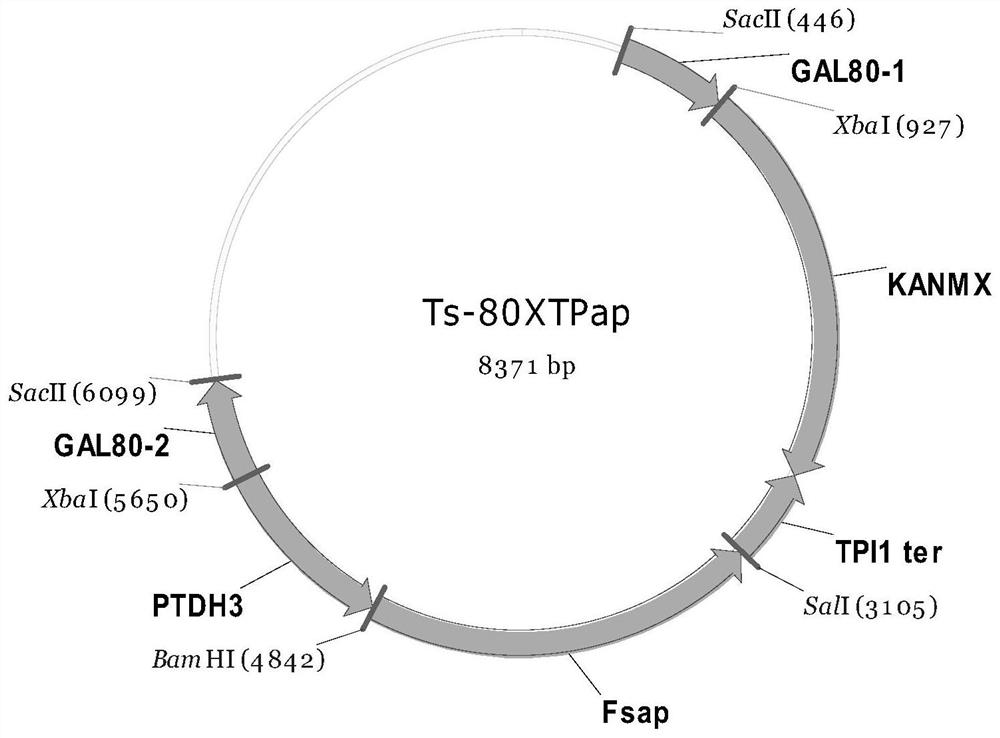Saccharomyces cerevisiae engineering bacteria for producing farnesene and application thereof
A technology of Saccharomyces cerevisiae and engineering bacteria, which is applied in the field of synthetic biology, can solve the problem that the influence of farnesene synthesis is not explained, and achieve the effect of simple gene manipulation
- Summary
- Abstract
- Description
- Claims
- Application Information
AI Technical Summary
Problems solved by technology
Method used
Image
Examples
Embodiment 1
[0045] Example 1: Construction of Saccharomyces cerevisiae farnesene synthetic strain
[0046] 1.1 Codon optimization of plant-derived farnesene synthase encoding gene and construction of integrated expression plasmid
[0047] Apple (Fsap, GenBank: AY787633.1), Soybean (Fsso, Glyma.13G321100), Artemisia annua (Fsaa, GenBank: AF374462.1) and Orange (Fscj, GenBank: AY835398.1) sources were obtained through NCBI and SoyBase. The gene sequence encoding ene synthase was sent to Suzhou Jinweizhi Biotechnology Co., Ltd. for codon optimization and gene synthesis. The codon-optimized Fsap (SEQ ID NO.1), Fsso (SEQ ID NO.2), Fsaa (SEQ ID NO.3) and Fscj (SEQ ID NO.4) were respectively connected to the pUC57 vector to obtain the plasmid pUC57 -Fsap, pUC57-Fsso, pUC57-Fsaa, pUC57-Fscj, the preservation host is Escherichia coli JM109. Plasmids pUC57-Fsso, pUC57-Fsaa, and pUC57-Fscj were digested with SalI and NheI, and fragments Fsso, Fsaa, and Fscj were obtained by gel recovery. pUC57-Fsa...
Embodiment 2
[0053] Example 2: Enhancing the Mevalonate Metabolic Pathway and Improving the Synthesis Ability of Engineering Bacteria Farnesene
[0054] 2.1 Mevalonate pathway gene enhanced integration expression plasmid construction
[0055] Using the genome of Saccharomyces cerevisiae YPH499 as a template, primers P5 and P6, P7 and P8, and P9 and P10 were used to amplify HMG1, P GAL10 -P GAL1 and ERG20; use primers P5 and P10 to obtain HP20 by fusion PCR amplification, and connect it to the pMD-19Tsimple vector; after the sequence is correct, digest it with SmaI, and recover from the gel to obtain HP20. Using the genome of Saccharomyces cerevisiae CICC 31906 as a template, primers P1 and P2, P3 and P4 were respectively amplified and then fused, connected to pMD-19T simple vector to obtain plasmid Ts-HIS3(R), digested with SmaI and connected with HP20 to obtain Integrate the expression plasmid Ts-HIS3-HPE ( Figure 7 ).
[0056] Using the genome of Saccharomyces cerevisiae YPH499 as a...
Embodiment 3
[0063] Example 3: Effects of Chromosomal Integration of Different Copy Numbers of HMG1 on Farnesene Synthesis
[0064] 3.1 Construction of Chromosomal Integration HMG1 Expression Plasmid
[0065] Using the genome of Saccharomyces cerevisiae YPH499 as a template, primers P5 and P6, P7 and P48 amplified HMG1 and P GAL10 -P GAL1 , HP was amplified by fusion PCR, connected to the pMD-19T simple vector, digested with SmaI and SalI after correct sequencing, recovered from gel to obtain HP, and filled with sticky ends as blunt ends. Using Ts-HIS3(R) as a template, reverse PCR amplification was performed with primers P2 and P3, and the vector was obtained by digestion with SmaI and SalI. The fragment was connected with the vector to obtain the integrated expression plasmid Ts-HIS3-HP ( Figure 13 ).
[0066] Using the genome of Saccharomyces cerevisiae YPH499 as a template, primers P47 and P6, P7 and P49 were used to amplify HMG1, P GAL10 -P GAL1 , HP was amplified by fusion PCR...
PUM
 Login to View More
Login to View More Abstract
Description
Claims
Application Information
 Login to View More
Login to View More - R&D
- Intellectual Property
- Life Sciences
- Materials
- Tech Scout
- Unparalleled Data Quality
- Higher Quality Content
- 60% Fewer Hallucinations
Browse by: Latest US Patents, China's latest patents, Technical Efficacy Thesaurus, Application Domain, Technology Topic, Popular Technical Reports.
© 2025 PatSnap. All rights reserved.Legal|Privacy policy|Modern Slavery Act Transparency Statement|Sitemap|About US| Contact US: help@patsnap.com



